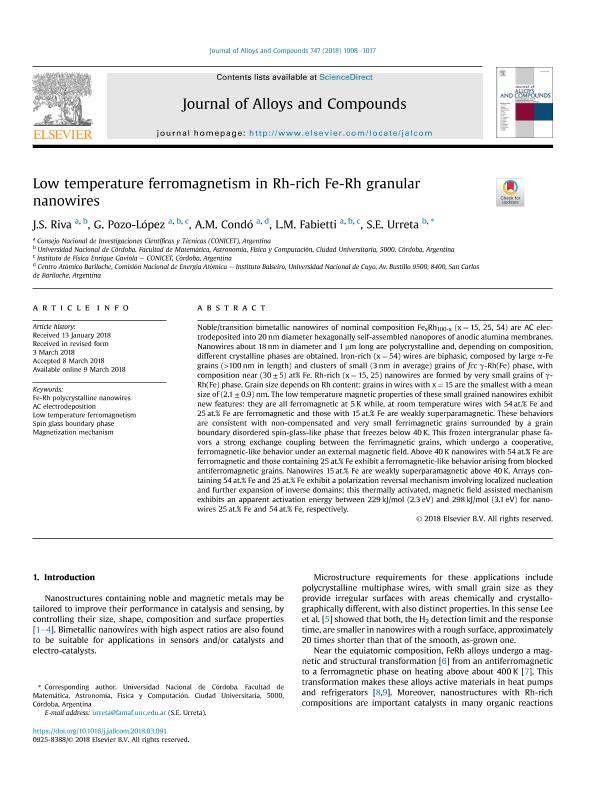Artículo
Low temperature ferromagnetism in Rh-rich Fe-Rh granular nanowires
Riva, Julieta Soledad ; Pozo Lopez, Gabriela del Valle
; Pozo Lopez, Gabriela del Valle ; Condo, Adriana Maria
; Condo, Adriana Maria ; Fabietti, Luis Maria Rodolfo
; Fabietti, Luis Maria Rodolfo ; Urreta, Silvia Elena
; Urreta, Silvia Elena
 ; Pozo Lopez, Gabriela del Valle
; Pozo Lopez, Gabriela del Valle ; Condo, Adriana Maria
; Condo, Adriana Maria ; Fabietti, Luis Maria Rodolfo
; Fabietti, Luis Maria Rodolfo ; Urreta, Silvia Elena
; Urreta, Silvia Elena
Fecha de publicación:
09/05/2018
Editorial:
Elsevier Science Sa
Revista:
Journal of Alloys and Compounds
ISSN:
0925-8388
Idioma:
Inglés
Tipo de recurso:
Artículo publicado
Clasificación temática:
Resumen
Noble/transition bimetallic nanowires of nominal composition FexRh100-x (x = 15, 25, 54) are AC electrodeposited into 20 nm diameter hexagonally self-assembled nanopores of anodic alumina membranes. Nanowires about 18 nm in diameter and 1 μm long are polycrystalline and, depending on composition, different crystalline phases are obtained. Iron-rich (x = 54) wires are biphasic, composed by large α-Fe grains (>100 nm in length) and clusters of small (3 nm in average) grains of fcc γ-Rh(Fe) phase, with composition near (30 ± 5) at% Fe. Rh-rich (x = 15, 25) nanowires are formed by very small grains of γ-Rh(Fe) phase. Grain size depends on Rh content: grains in wires with x = 15 are the smallest with a mean size of (2.1 ± 0.9) nm. The low temperature magnetic properties of these small grained nanowires exhibit new features: they are all ferromagnetic at 5 K while, at room temperature wires with 54 at.% Fe and 25 at.% Fe are ferromagnetic and those with 15 at.% Fe are weakly superparamagnetic. These behaviors are consistent with non-compensated and very small ferrimagnetic grains surrounded by a grain boundary disordered spin-glass-like phase that freezes below 40 K. This frozen intergranular phase favors a strong exchange coupling between the ferrimagnetic grains, which undergo a cooperative, ferromagnetic-like behavior under an external magnetic field. Above 40 K nanowires with 54 at.% Fe are ferromagnetic and those containing 25 at.% Fe exhibit a ferromagnetic-like behavior arising from blocked antiferromagnetic grains. Nanowires 15 at.% Fe are weakly superparamagnetic above 40 K. Arrays containing 54 at.% Fe and 25 at.% Fe exhibit a polarization reversal mechanism involving localized nucleation and further expansion of inverse domains; this thermally activated, magnetic field assisted mechanism exhibits an apparent activation energy between 229 kJ/mol (2.3 eV) and 298 kJ/mol (3.1 eV) for nanowires 25 at.% Fe and 54 at.% Fe, respectively.
Archivos asociados
Licencia
Identificadores
Colecciones
Articulos(CCT - CORDOBA)
Articulos de CTRO.CIENTIFICO TECNOL.CONICET - CORDOBA
Articulos de CTRO.CIENTIFICO TECNOL.CONICET - CORDOBA
Articulos(CCT - PATAGONIA NORTE)
Articulos de CTRO.CIENTIFICO TECNOL.CONICET - PATAGONIA NORTE
Articulos de CTRO.CIENTIFICO TECNOL.CONICET - PATAGONIA NORTE
Articulos(IFEG)
Articulos de INST.DE FISICA ENRIQUE GAVIOLA
Articulos de INST.DE FISICA ENRIQUE GAVIOLA
Citación
Riva, Julieta Soledad; Pozo Lopez, Gabriela del Valle; Condo, Adriana Maria; Fabietti, Luis Maria Rodolfo; Urreta, Silvia Elena; Low temperature ferromagnetism in Rh-rich Fe-Rh granular nanowires; Elsevier Science Sa; Journal of Alloys and Compounds; 747; 9-5-2018; 1008-1017
Compartir
Altmétricas



